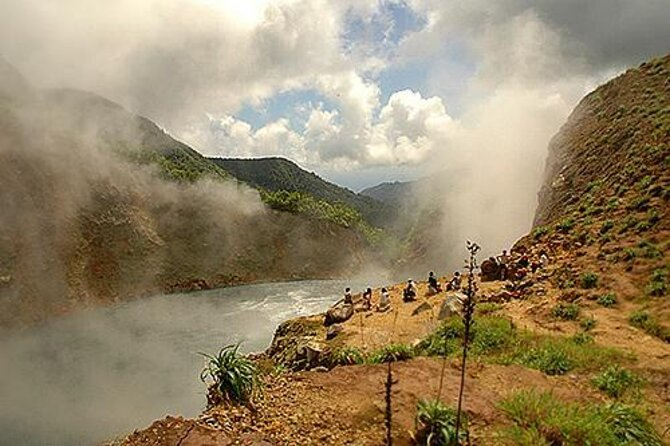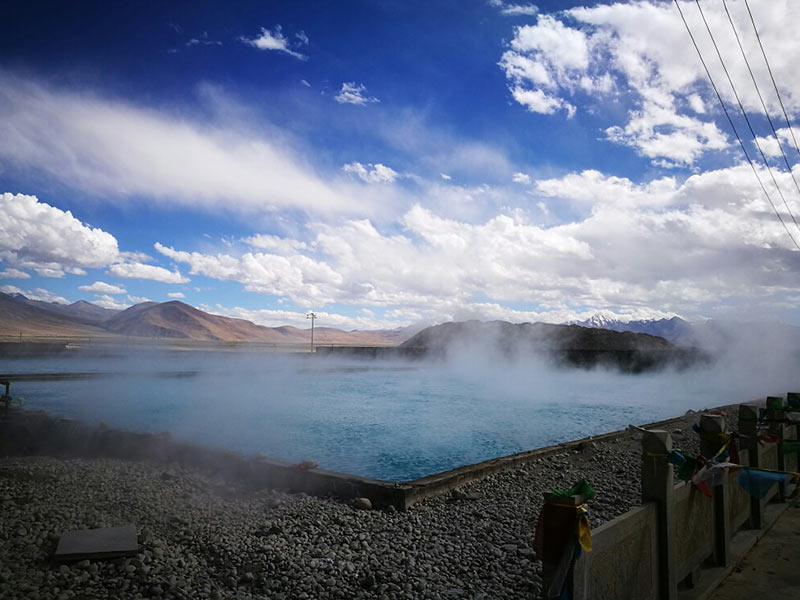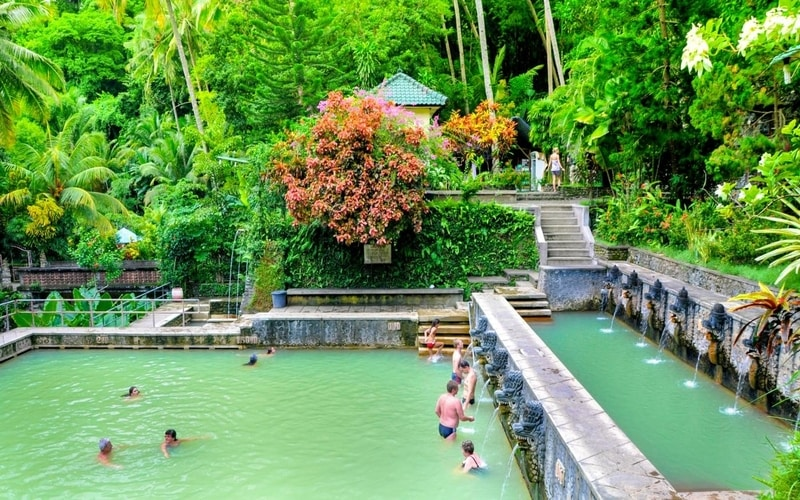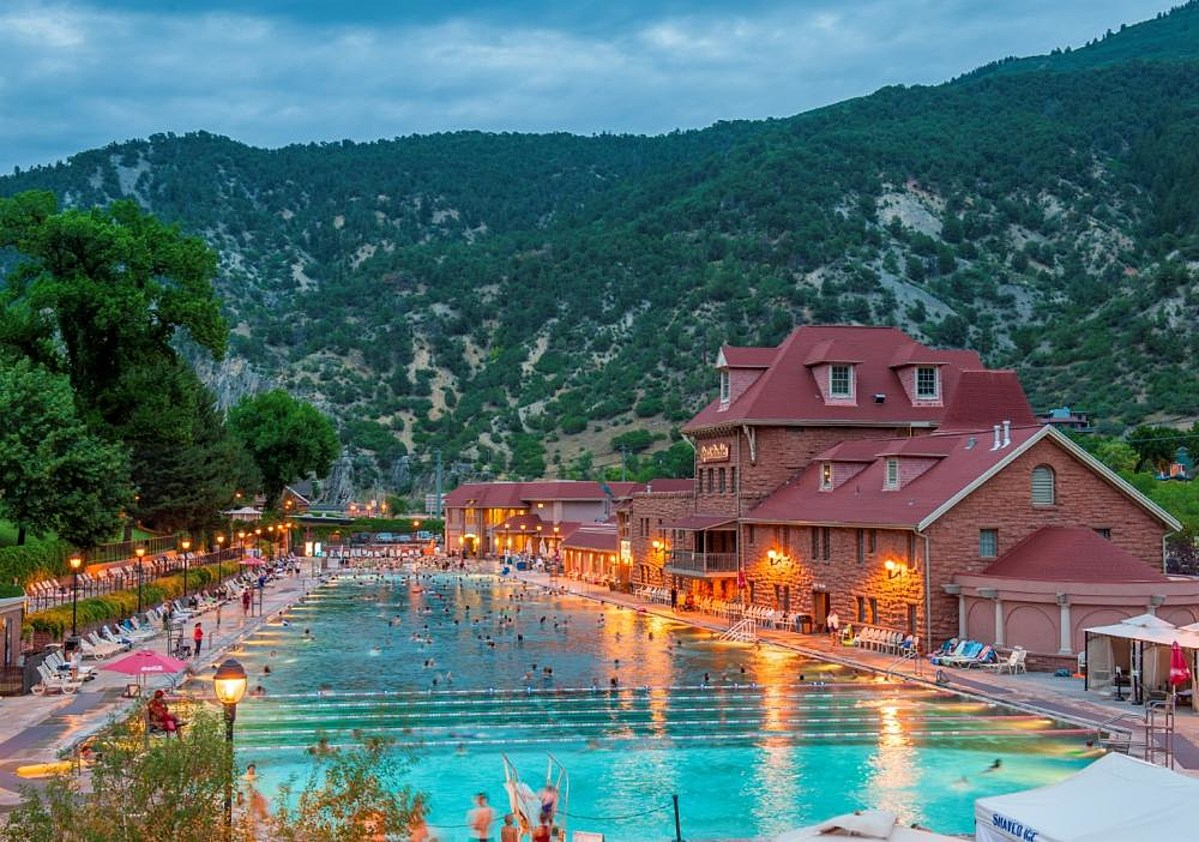Hot springs have been a source of fascination and relaxation for humans throughout history. These naturally occurring geothermal pools are created when groundwater is heated by magma or hot rocks deep beneath the Earth’s surface. The heated water then rises through cracks and fissures, emerging as a hot spring on the surface.
Hot springs can be found all over the world, from the mountains of Japan to the valleys of Iceland. They vary in size, temperature, and mineral content, but all offer a unique and rejuvenating experience for those who visit them. In this article, we will explore the top 12 largest hot springs in the world, taking you on a journey through some of the most stunning and impressive geothermal wonders our planet has to offer.
The Grand Prismatic Spring, Yellowstone National Park, USA

The Grand Prismatic Spring in Yellowstone National Park is the largest hot spring in the United States and the third-largest in the world. This stunning geothermal feature is known for its vibrant colors, which range from deep blue at the center to bright green, yellow, and orange at the edges. The colors are caused by different species of heat-loving bacteria that thrive in the mineral-rich water.
The Grand Prismatic Spring is approximately 370 feet (110 meters) in diameter and over 121 feet (37 meters) deep. The water temperature at the center of the spring can reach up to 189°F (87°C), making it far too hot for humans to enter. However, visitors can admire the spring’s beauty from a series of boardwalks and trails that wind through the area.
Frying Pan Lake, Waimangu Volcanic Valley, New Zealand

Frying Pan Lake, located in the Waimangu Volcanic Valley of New Zealand, is the world’s largest hot spring. This massive geothermal pool measures approximately 38,000 square meters (409,000 square feet) in size and reaches temperatures of up to 200°F (93°C).
The lake was formed in 1886 after the eruption of Mount Tarawera, which created a series of craters and fissures in the surrounding area. The water in Frying Pan Lake is acidic, with a pH level of around 3.5, and contains high levels of minerals such as silica, sulfur, and arsenic.
Despite its inhospitable conditions, Frying Pan Lake is a popular tourist attraction, with visitors coming from all over the world to witness its steaming, turquoise waters and the unique geothermal landscape that surrounds it.
Boiling Lake, Dominica

Boiling Lake in Dominica is the second-largest hot spring in the world, measuring approximately 60 meters (200 feet) in diameter. As its name suggests, the water in this lake is constantly boiling, with temperatures reaching up to 180-197°F (82-92°C).
The lake is situated in the Morne Trois Pitons National Park, a UNESCO World Heritage site known for its lush rainforests, stunning waterfalls, and unique geothermal features. To reach Boiling Lake, visitors must embark on a challenging, 8-mile (13-kilometer) round-trip hike through the park’s rugged terrain.
The water in Boiling Lake is grayish-blue in color and is constantly churning and bubbling, creating a mesmerizing and somewhat intimidating spectacle. The lake’s heat and acidity make it impossible for any aquatic life to survive, but the surrounding area is home to a diverse array of plant and animal species adapted to the harsh conditions.
Deildartunguhver, Iceland

Deildartunguhver is the largest hot spring in Iceland and the most powerful hot spring in Europe. This impressive geothermal feature releases around 180 liters (48 gallons) of boiling water per second, with temperatures reaching up to 206°F (97°C).
The hot spring is located in the town of Reykholt in western Iceland, approximately 65 miles (105 kilometers) from the capital city of Reykjavik. The water from Deildartunguhver is used for heating homes and greenhouses in the surrounding area, as well as for bathing in the nearby Krauma geothermal baths.
Visitors to Deildartunguhver can admire the massive plumes of steam rising from the spring and feel the incredible heat emanating from the boiling water. The area around the hot spring is also home to a variety of geothermal features, including smaller hot springs, mud pots, and fumaroles.
Ōita Prefecture, Japan

The Ōita Prefecture in Japan is home to a large concentration of hot springs, known as onsen. This area, located on the island of Kyushu, boasts over 4,300 hot spring vents and wells, making it one of the most geothermally active regions in the world.
The largest hot spring in the Ōita Prefecture is the Beppu Hot Spring, which releases over 200,000 liters (52,800 gallons) of water per day. The Beppu area is known for its “hells” or jigoku, which are a series of eight hot springs with unique characteristics and colors.
Some of the most notable “hells” in Beppu include the “Blood Pond Hell” (Chinoike Jigoku), which has deep red water due to the presence of iron oxide, and the “Sea Hell” (Umi Jigoku), which has vibrant blue water caused by the high concentration of cobalt. Visitors to Beppu can tour the various “hells” and even try cooking foods like eggs and vegetables in the boiling waters.
Yangbajing Hot Springs, Tibet

The Yangbajing Hot Springs in Tibet are the highest-altitude hot springs in the world, located at an elevation of around 4,500 meters (14,760 feet) above sea level. These hot springs are part of the Yangbajing Geothermal Field, which covers an area of approximately 30 square kilometers (11.6 square miles).
The Yangbajing Hot Springs are known for their therapeutic properties, with many visitors coming to bathe in the mineral-rich waters to alleviate ailments such as arthritis, skin conditions, and digestive issues. The springs are also an important religious site for Tibetan Buddhists, who believe that bathing in the sacred waters can help cleanse the body and soul.
The largest hot spring in the Yangbajing Geothermal Field is the Yangbajing Great Fountain, which releases boiling water and steam up to 30 meters (98 feet) into the air. The area around the hot springs is also home to a number of geothermal power plants, which harness the energy from the hot water and steam to generate electricity for the region.
Glenwood Springs, Colorado, USA

Glenwood Springs in Colorado is home to the world’s largest hot springs pool, which measures over 400 feet (122 meters) in length and contains over 1 million gallons (3.8 million liters) of mineral-rich water. The pool is fed by the Yampah Spring, which produces over 3.5 million gallons (13.2 million liters) of water per day at a temperature of 122°F (50°C).
The Glenwood Hot Springs Pool is a popular destination for tourists and locals alike, offering a variety of activities such as swimming, soaking, and relaxing on the pool’s large sundeck. The water in the pool is rich in minerals like calcium, magnesium, and sulfate, which are known for their therapeutic benefits.
In addition to the main pool, Glenwood Springs is also home to several other hot springs and geothermal attractions, including the Yampah Spa and Vapor Caves, where visitors can enjoy steamy underground caverns and mineral-rich steam baths.
Pamukkale Thermal Pools, Turkey

The Pamukkale Thermal Pools in Turkey are a series of stunning white calcium carbonate travertine terraces filled with mineral-rich hot spring water. The name “Pamukkale” translates to “cotton castle” in Turkish, referring to the whiteness of the terraces that resemble a snowy landscape.
The hot spring water that feeds the Pamukkale Thermal Pools is rich in calcium, magnesium, and bicarbonate, which contribute to the formation of the white travertine terraces. As the hot water cools and evaporates, it leaves behind layers of calcium carbonate, which build up over time to create the unique geological formations.
Visitors to Pamukkale can explore the terraces and soak in the warm, mineral-rich waters of the thermal pools. The site also includes the ruins of the ancient Roman city of Hierapolis, which was built around the hot springs and features well-preserved Roman baths, temples, and other structures.
Saturnia Hot Springs, Italy

The Saturnia Hot Springs in Tuscany, Italy, are a series of natural thermal pools famous for their vibrant blue-green color and the legend surrounding their creation. According to Roman mythology, the hot springs were formed when Jupiter, the king of the gods, threw a lightning bolt at Saturn, causing him to fall to Earth and create the thermal pools.
The water in the Saturnia Hot Springs is rich in sulfur, calcium, and carbon dioxide, which are believed to have therapeutic properties for skin conditions, arthritis, and respiratory issues. The springs maintain a constant temperature of around 99.5°F (37.5°C) and flow at a rate of about 500 liters (132 gallons) per second.
Visitors to the Saturnia Hot Springs can soak in the free outdoor thermal pools or visit one of the many spa resorts in the area that offer additional amenities and treatments. The picturesque Tuscan countryside surrounding the springs adds to the relaxing and rejuvenating atmosphere.
Ma’in Hot Springs, Jordan

The Ma’in Hot Springs in Jordan are a series of cascading waterfalls and thermal pools located in a stunning desert oasis. The springs are fed by a natural geothermal aquifer, which heats the water to temperatures between 104-145°F (40-63°C).
The mineral-rich water in the Ma’in Hot Springs is believed to have healing properties, and visitors come from all over the world to soak in the pools and enjoy the therapeutic benefits. The springs are surrounded by lush vegetation, creating a unique and picturesque contrast to the arid desert landscape.
In addition to the natural hot spring pools, the Ma’in area is home to several spa resorts that offer a range of treatments and facilities, including mud baths, hydrotherapy, and massage services. Visitors can also explore nearby attractions, such as the Dead Sea and the ancient city of Petra.
Banjar Hot Springs, Indonesia

The Banjar Hot Springs, located in Bali, Indonesia, are a series of natural hot spring pools nestled in a lush tropical setting. The springs are fed by a geothermal source beneath the Batur volcano, which heats the water to a comfortable temperature of around 100-104°F (38-40°C).
The Banjar Hot Springs feature three main pools, each with unique characteristics. The largest pool is designed for swimming and relaxation, while the two smaller pools are known for their therapeutic properties, with one containing high levels of sulfur and the other rich in iron.
The hot springs are surrounded by beautifully landscaped gardens, featuring tropical plants, stone carvings, and traditional Balinese architecture. Visitors can enjoy soaking in the pools, exploring the gardens, and indulging in traditional Balinese massages and spa treatments offered on-site.
Chena Hot Springs, Alaska, USA

Chena Hot Springs in Alaska is a unique geothermal destination located in the heart of the state’s interior. The springs are fed by a natural geothermal source that heats the water to a temperature of up to 106°F (41°C), providing a warm and inviting oasis amidst Alaska’s cold climate.
The Chena Hot Springs Resort offers a variety of activities and attractions for visitors, including soaking in the hot spring pools, enjoying the Aurora Ice Museum (a year-round ice sculpture gallery), and witnessing the spectacular Northern Lights displays during the winter months.
The resort also features a geothermal-powered greenhouse, which grows fresh produce for the on-site restaurant, and a renewable energy project that harnesses the geothermal energy to power the resort’s facilities. Visitors can learn about the sustainable practices and innovative technologies used at Chena Hot Springs through guided tours and educational programs.
Conclusion
The world’s largest hot springs offer a captivating glimpse into the power and beauty of the Earth’s geothermal wonders. From the colorful Grand Prismatic Spring in Yellowstone to the cascading waterfalls of Ma’in Hot Springs in Jordan, each of these destinations showcases the unique geological and ecological features that make hot springs so special.
Not only do these hot springs provide opportunities for relaxation, rejuvenation, and therapeutic benefits, but they also serve as important reminders of the delicate balance between our planet’s natural resources and the life they support. As we continue to explore and appreciate these magnificent geothermal treasures, it is crucial that we also work to protect and preserve them for generations to come.
Whether you are a seasoned hot spring enthusiast or simply seeking a new and exciting adventure, the top 12 largest hot springs in the world offer an unforgettable experience that combines the raw power of nature with the soothing and restorative properties of geothermal waters. So pack your bags, grab your swimsuit, and prepare to immerse yourself in some of the most awe-inspiring and invigorating destinations our planet has to offer.

